Exploring the different types of ergonomic standing desks is key in today’s health-conscious and dynamic work environments. Whether someone focusing on sustainability and self-sufficiency or a part of the general public looking for a healthier work setup, this guide is tailored for you.
The different types of standing desks include manual adjustable, electric adjustable, fixed-height, wall-mounted, and portable designs. Each type offers unique advantages and functionalities, catering to various needs and workstyles.
Ready to dive deeper into the world of standing desks? In the sections ahead, we’ll explore each type of standing desk in detail, discuss essential accessories and features, and guide you through key considerations to keep in mind when making your choice.
The Benefits of Using Standing Desks
Standing desks have gained immense popularity in modern workplaces, primarily due to their significant health and productivity advantages. These innovative workstations are more than just a trend; they are a response to the increasing recognition of the health risks associated with prolonged sitting. Are standing desks really better for you? Let’s explore the benefits.
Health Benefits of Standing Desks
- Reduced Risk of Obesity: Multiple studies have found that standing and moving more throughout the day can significantly reduce the risk of obesity. This is partly due to the increased number of calories burned when standing compared to sitting.
- Lower Risk of Metabolic Problems and Type 2 Diabetes: Extensive research has shown a correlation between prolonged sitting and a decrease in the body’s ability to regulate glucose levels, increasing the risk of type 2 diabetes and other metabolic issues.
- Decreased Risk of Cardiovascular Disease: Historical and recent studies indicate that sitting for extended periods significantly increases the risk of cardiovascular disease. For example, a study comparing London bus drivers (who sit) and bus conductors (who stand) revealed a higher incidence of heart-related issues in the former group.
- Reduced Cancer Risk: There’s evidence suggesting that prolonged sitting may be linked to a higher risk of various cancers, including breast and colon cancer. The exact mechanisms are still being studied, but certain biomarkers related to cancer have been found in higher levels in individuals who sit for long periods.
- Improved Longevity: Research indicates a direct correlation between the amount of time spent sitting and the overall risk of premature death. Reducing sitting time, along with understanding the recommended duration for standing, could significantly increase life expectancy.
Productivity and Comfort
- Enhanced Productivity and Concentration: A study titled “Stand Up to Work” revealed that people using height-adjustable desks reported improved productivity and concentration. This is attributed to the reduced discomfort and the flexibility to alternate between sitting and standing, as highlighted in Steelcase’s research.
- Reduced Physical Discomfort: Users of height-adjustable desks have reported a significant reduction in discomfort in areas like the back, shoulders, and neck, as they have the option to change their posture throughout the day.
- Encourages a More Active Lifestyle: By facilitating movement and changes in posture throughout the workday, standing desks promote a more active lifestyle even during work hours.
You might be interested in understanding the potential impact of standing desk on your vein health.
5 Types of Standing Desks
Selecting the right type of standing desk is crucial to cater to your specific needs and working style. From manual to electric, and even portable options, each type offers unique benefits and functionalities.
Let’s dive into the specifics of each type to help you make an informed decision that aligns with your workspace requirements.
1. Manual Adjustable Standing Desks
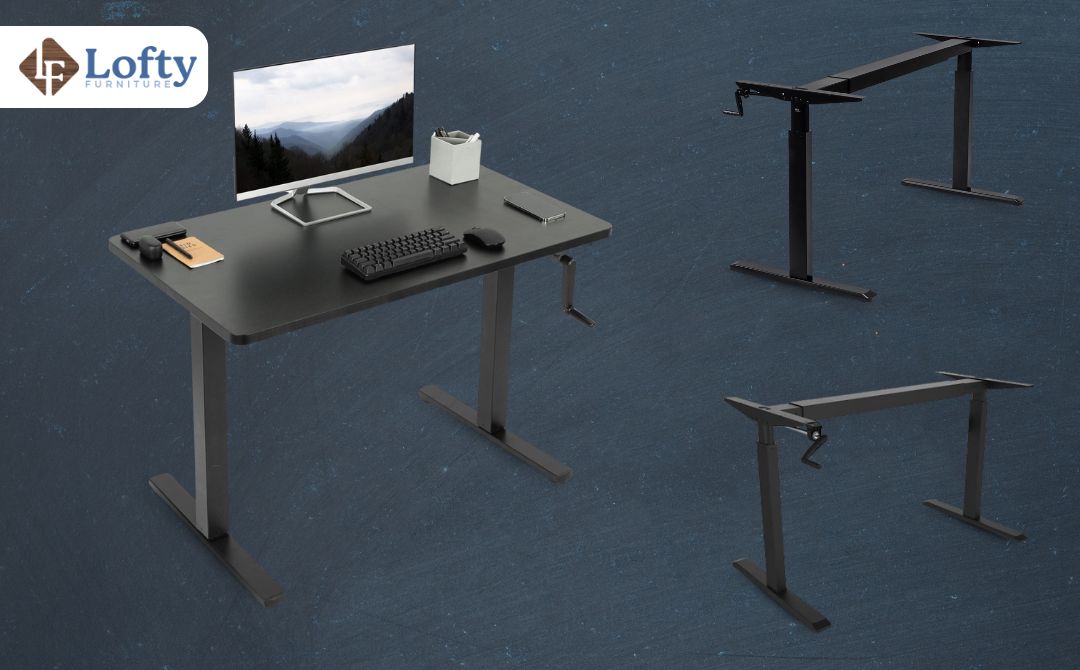
For those of you who prefer a more hands-on approach, manual adjustable standing desks offer a straightforward and reliable option. These desks typically use a mechanical crank or pneumatic lift system to adjust the height, giving you full control over your workspace.
Manual adjustable desks are known for their durability and simplicity. Since they don’t rely on electricity, they’re ideal for environments where power access is limited or for those who prefer a more eco-friendly option. Brands like Fully and IKEA offer some of the top models in this category, known for their quality and affordability.
When choosing a manual desk, consider the ease of height adjustment. A desk that’s difficult to adjust might discourage you from changing positions regularly. Also, look at the desk’s weight capacity and ensure it can accommodate your setup. Remember, the key is finding a desk that seamlessly integrates into your workflow, encouraging movement and adaptability.
2. Electric Adjustable Standing Desks
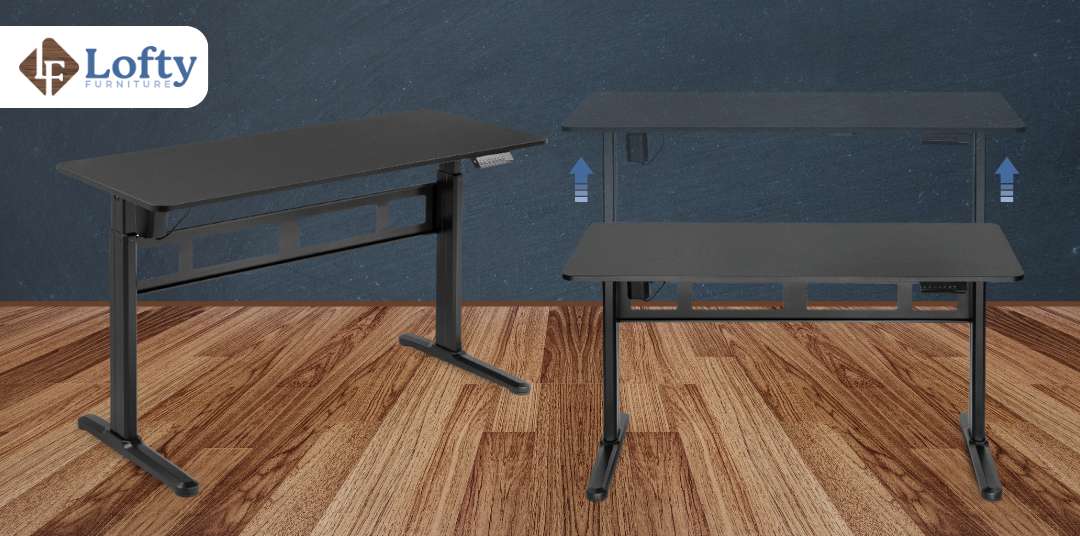
Electric standing desks provide a blend of technology and ergonomics, making height adjustment as simple as pressing a button. These desks are ideal if you’re looking for convenience and ease of use.
The electric mechanism allows for smooth and precise height adjustments, perfect for quickly switching between sitting and standing. Brands like UPLIFT Desk and Vari offer popular models, each with unique features like programmable height settings and integrated cable management. When comparing models, pay attention to the motor’s noise level and speed of height adjustment.
When purchasing an electric desk, consider the power requirements and ensure that your workspace can accommodate it. Additionally, check the warranty and customer support options, as these desks involve more complex components. Electric desks can be an excellent investment for your health and productivity, provided you choose one that aligns with your needs and workspace requirements.
3. Fixed-Height Standing Desks
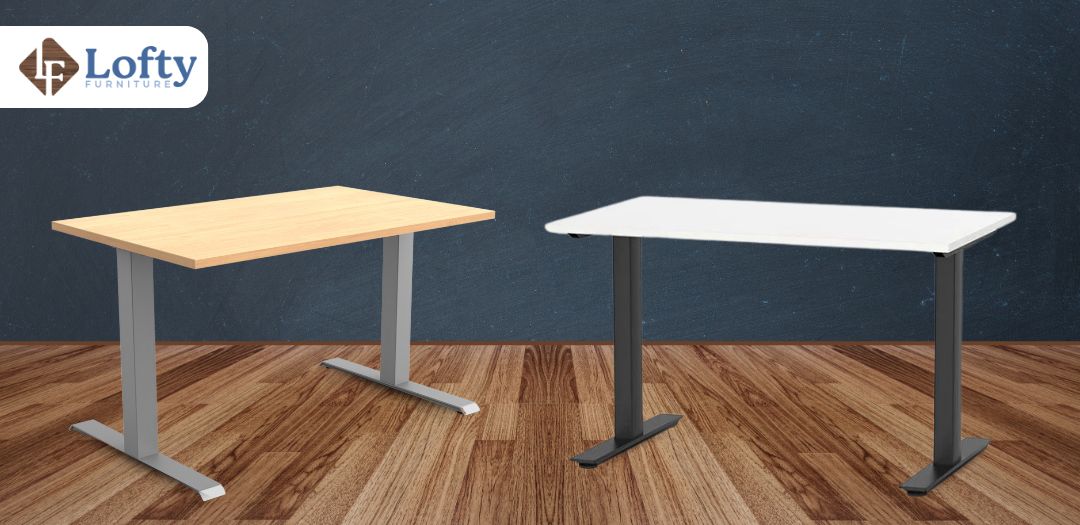
Fixed-height standing desks are a straightforward solution for those who prefer a static working height. While they lack the adjustability of their counterparts, they offer stability and can be a more budget-friendly option.
The key advantage of fixed-height desks is their simplicity and reliability. Without moving parts, these desks tend to be durable and require minimal maintenance. For those who might find the constant adjustment of height a distraction, a fixed-height desk can provide a stable and focused work environment. Sit-stand desk converters are a cost-effective and space-efficient way to turn your existing desk into a standing desk without the need for a full replacement.
Customization options for fixed-height desks can include various sizes, materials, and designs to fit your workspace aesthetics. However, it’s crucial to choose the right height to match your ergonomic needs. Measure your standing elbow height to ensure that your desk aligns with your forearm for comfortable typing and viewing.
4. Wall-Mounted Standing Desks
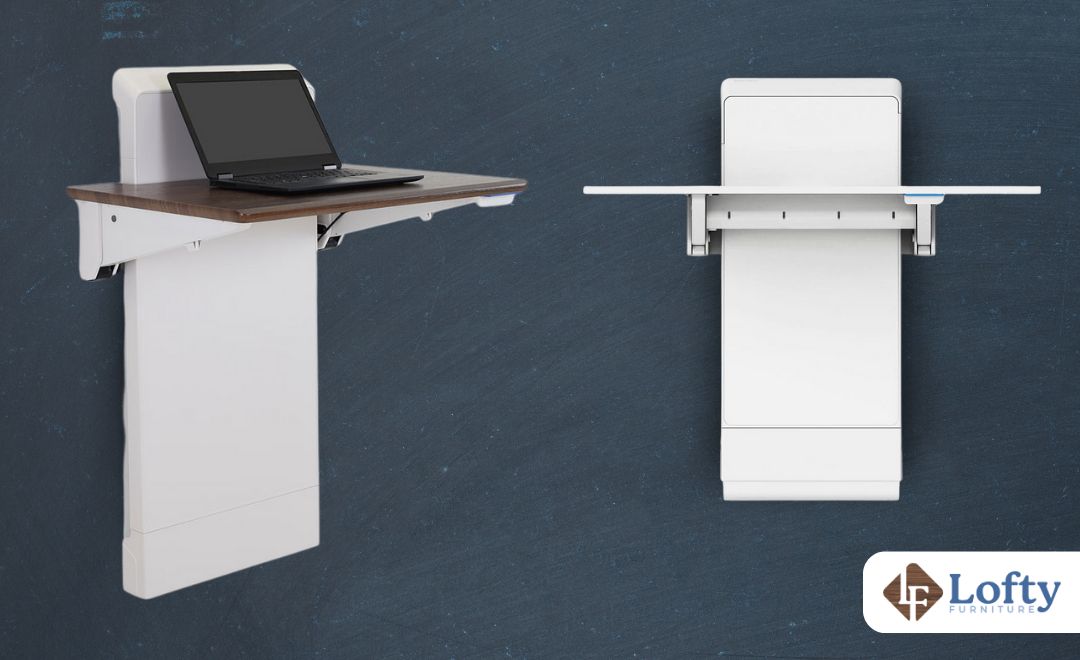
Wall-mounted standing desks are an excellent space-saving solution, particularly for small offices or home workspaces. These desks are fixed to the wall and can often be folded away when not in use, maximizing your space efficiency.
The installation process is a critical consideration for wall-mounted desks. You’ll need to ensure your wall can support the desk and its contents, and you may require professional installation depending on the complexity of the desk. Once installed, these desks provide a sturdy, space-efficient workspace that can be customized to your height requirements.
Popular brands for wall-mounted desks include Ergotron and Humanscale, known for their innovative designs and quality construction. When choosing a wall-mounted desk, consider the desk’s weight capacity and the available workspace. Look for models that offer additional features like integrated cable management or additional storage.
5. Portable Standing Desks

Portable standing desks are designed for versatility and convenience, making them ideal for those who work in different locations or have limited space. These desks are lightweight, easy to move, and often foldable, allowing you to create a standing workstation wherever you go.
Portable desk designs vary widely, from simple tabletop risers to fully collapsible structures. Materials used in these desks are typically lightweight yet durable, like aluminum or high-grade plastic. This portability doesn’t mean compromising on stability; many portable desks are surprisingly sturdy and can support a standard laptop and accessories setup.
The practical applications for portable standing desks are vast. They’re perfect for freelancers, students, professionals, or even gamers. Whether you’re working from a coffee shop or moving between conference rooms, a portable standing desk can help you maintain an ergonomic workspace.
Accessories and Features
Enhancing your standing desk experience goes beyond just choosing the right desk; it’s also about the accessories and features that accompany it. Items like anti-fatigue mats, cable management solutions, balance boards, and ergonomic accessories play a pivotal role in maximizing comfort and efficiency.
We’ll explore these crucial additions to ensure your standing desk setup is both functional and comfortable.
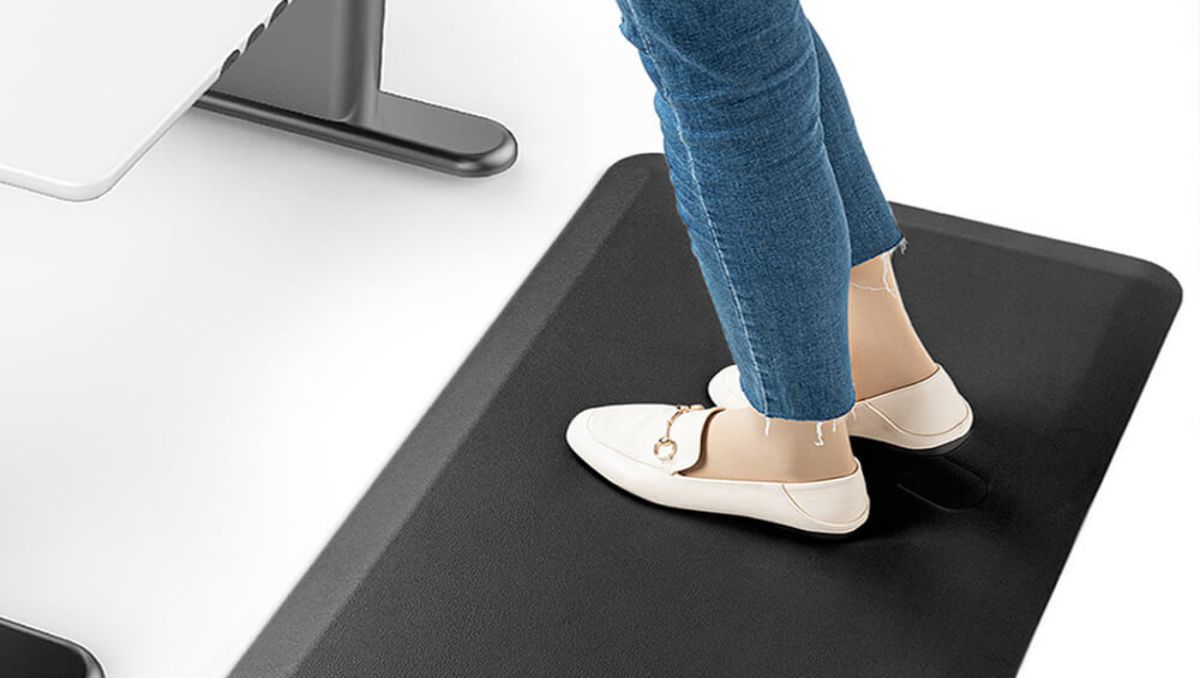
Anti-Fatigue Mats
Standing desks are all about improving your comfort and health, but standing for prolonged periods can be tiring. That’s where anti-fatigue mats come in – they’re designed to reduce the strain on your legs and back, making standing more comfortable.
When choosing an anti-fatigue mat, consider the material and thickness. A good mat should provide enough cushioning to reduce fatigue but not so much that it becomes difficult to maintain balance or move around. Look for mats made from high-density foam or gel, as these materials offer the best combination of comfort and support.
Also, consider the size of the mat and ensure it fits your standing area. You should have enough room to move around slightly, which promotes circulation and reduces the likelihood of discomfort or fatigue. A quality anti-fatigue mat is an investment in your health and can significantly enhance your standing desk experience.
Cable Management Solutions
With any desk setup, managing cables and cords is crucial to maintaining an organized and efficient workspace. This becomes even more important with standing desks, as the movement and height adjustment can lead to tangled cables.
Effective cable management involves organizing and securing your cables to prevent them from becoming a hazard or interfering with your desk’s functionality. Look for cable management solutions like under-desk trays, cable clips, and cable sleeves that keep cords neatly bundled and out of the way.
When selecting cable management products, consider the types and number of cables you need to organize. Some solutions are better suited for heavy-duty power cables, while others are ideal for smaller data cables. A well-organized cable system not only improves the aesthetics of your workspace but also enhances safety and functionality.
Ergonomic Accessories
To maximize the benefits of your standing desk, incorporating ergonomic accessories is essential. These accessories, like monitor arms, keyboard trays, and other add-ons, are designed to optimize your posture and comfort, reducing the risk of strain and injury.
Monitor arms allow you to adjust the height, depth, and angle of your monitor, ensuring that it’s at the optimal eye level and reducing neck strain.
Keyboard trays help maintain a neutral wrist position, which is crucial for preventing repetitive strain injuries.
Other ergonomic accessories, such as footrests or ergonomic chairs (also known as office chairs), can further enhance your comfort and posture.
When selecting these accessories, consider how they integrate with your existing setup and your specific ergonomic needs. The goal is to create a workspace that promotes natural, comfortable postures, allowing you to work more efficiently and comfortably.
Height Memory Settings
One of the most convenient features of modern standing desks is the ability to save preset height positions. This feature is particularly beneficial if you frequently switch between sitting and standing or if your desk is used by multiple people.
Desks with height memory settings allow you to save your preferred standing and sitting heights, making adjustments quick and effortless. This convenience encourages more frequent movement, as you can easily switch positions with the push of a button.
When looking for a desk with height memory settings, consider the number of presets available and the ease of programming them. Some desks offer additional features like digital displays or smartphone integration, providing even more convenience and customization.
Considerations When Choosing a Standing Desk
When it comes to selecting the perfect standing desk, several key factors come into play. Considering aspects such as space availability, weight capacity, budget, and aesthetic preferences will guide you towards the ideal choice for your workspace.
Let’s break down these important considerations to help you find a standing desk that fits your unique needs and lifestyle.
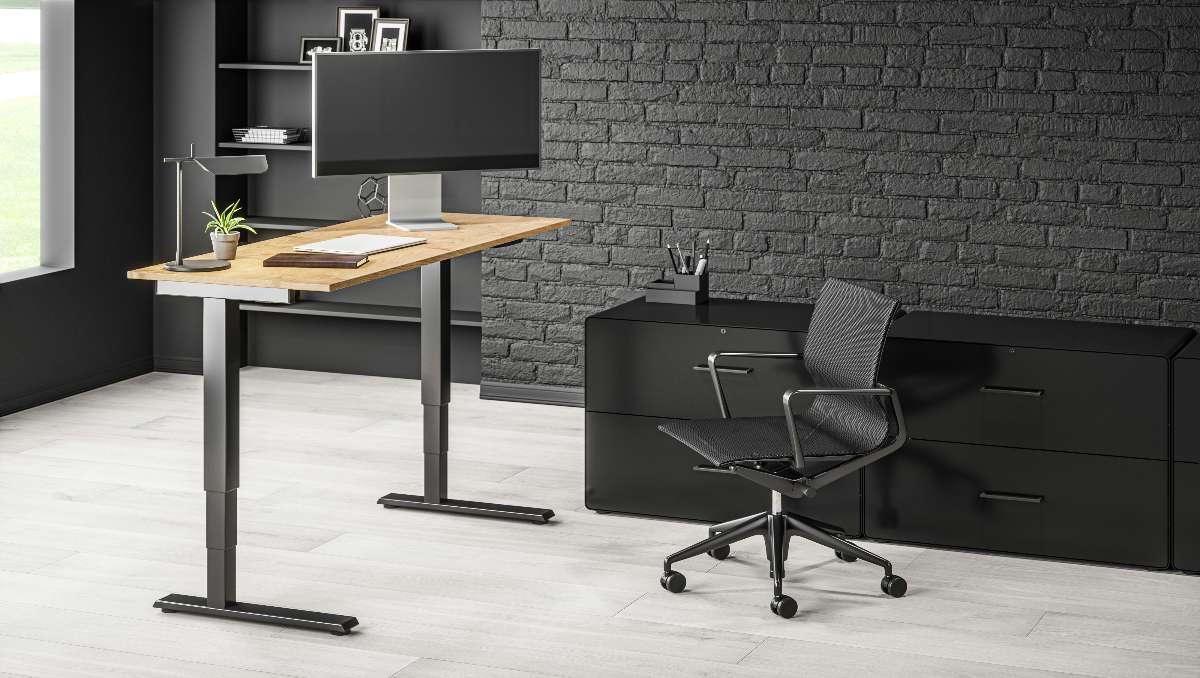
Space availability and desk size
When selecting a standing desk, the first thing to consider is the amount of space you have available. Measure your workspace to ensure the standing desk size will fit comfortably, leaving enough room for movement and other office essentials.
Weight capacity and stability
It’s crucial to consider the weight capacity and stability of your standing desk, especially if you plan to place multiple monitors or heavy equipment on it. A stable desk will remain firm and steady at all heights, ensuring a safe and comfortable working environment.
Price range and budget considerations
Standing desks come in a wide range of prices, so it’s important to set a budget before you start shopping. Keep in mind that investing in a quality desk can pay off in the long run in terms of durability and ergonomic benefits.
Aesthetics and design preferences
Finally, consider the aesthetics and design of the standing desk. Choose a style and color that complements your workspace and reflects your personal taste. A desk that you find visually appealing will make your work environment more enjoyable.
Final Thoughts
In conclusion, standing desks offer a dynamic and health-conscious alternative to traditional sitting desks. Whether you opt for a manual, electric, fixed-height, wall-mounted, or portable desk, the key is to find one that suits your specific needs and enhances your workspace. Remember, the right desk can significantly improve your comfort, health, and productivity.
As Dr. James Levine, a professor of medicine at the Mayo Clinic, famously said, “Sitting is the new smoking.” This quote highlights the growing awareness of the health risks associated with prolonged sitting and underscores the importance of integrating more movement into our daily lives. Standing desks are a step in the right direction, offering a practical solution to the sedentary lifestyle many of us lead.
Ultimately, the best standing desk for you is one that fits into your workspace, meets your ergonomic needs, and encourages a balance between sitting and standing. Consider the various types, features, and accessories available to create an environment that not only boosts your productivity but also supports your overall well-being. Happy standing!
Pair your standing desk with movement for maximum health benefits!
Discover our Walking Pads & Treadmills to keep active and boost productivity.
